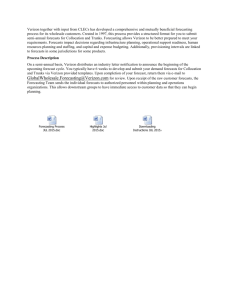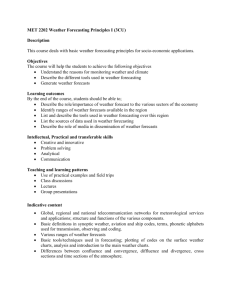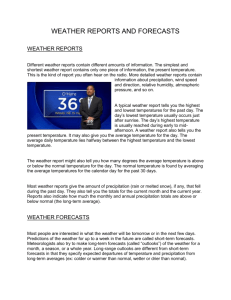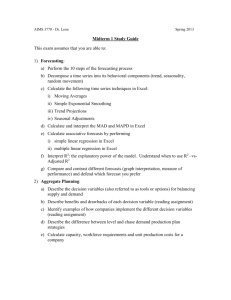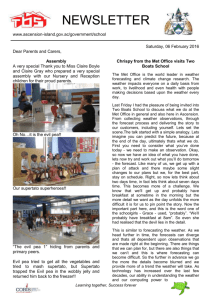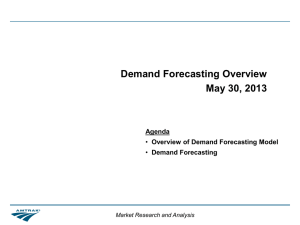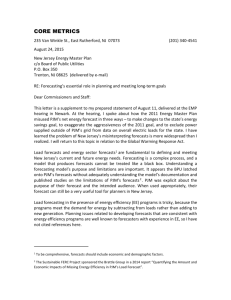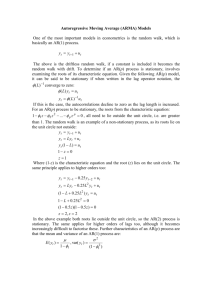Sales Forecasting (CB719)
advertisement
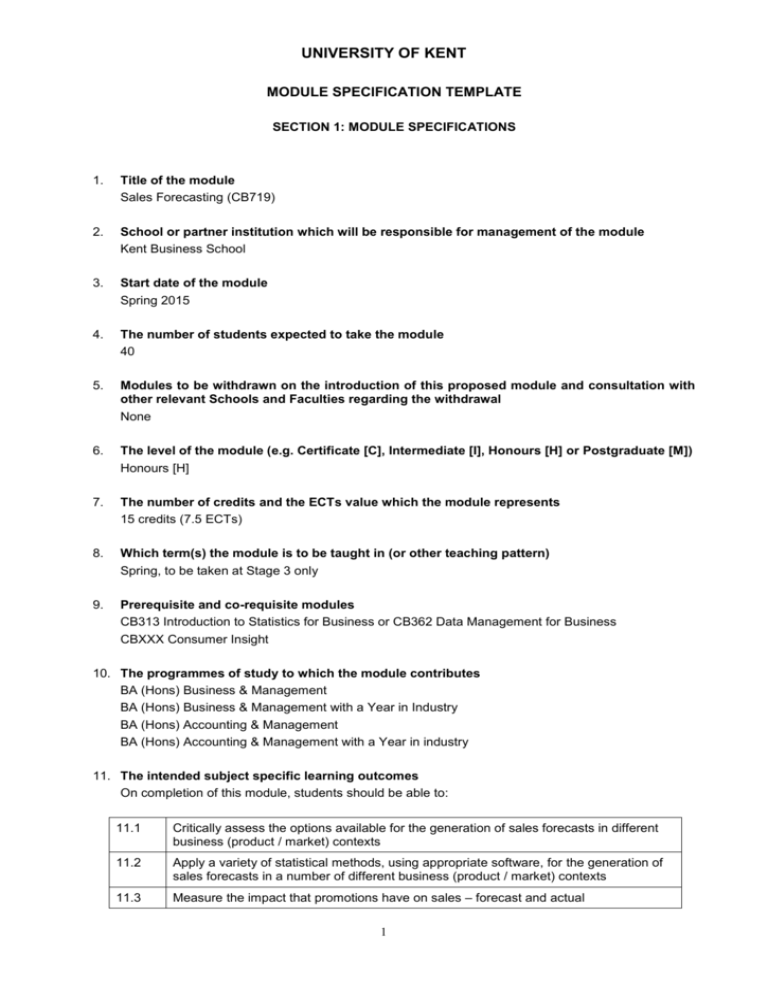
UNIVERSITY OF KENT MODULE SPECIFICATION TEMPLATE SECTION 1: MODULE SPECIFICATIONS 1. Title of the module Sales Forecasting (CB719) 2. School or partner institution which will be responsible for management of the module Kent Business School 3. Start date of the module Spring 2015 4. The number of students expected to take the module 40 5. Modules to be withdrawn on the introduction of this proposed module and consultation with other relevant Schools and Faculties regarding the withdrawal None 6. The level of the module (e.g. Certificate [C], Intermediate [I], Honours [H] or Postgraduate [M]) Honours [H] 7. The number of credits and the ECTs value which the module represents 15 credits (7.5 ECTs) 8. Which term(s) the module is to be taught in (or other teaching pattern) Spring, to be taken at Stage 3 only 9. Prerequisite and co-requisite modules CB313 Introduction to Statistics for Business or CB362 Data Management for Business CBXXX Consumer Insight 10. The programmes of study to which the module contributes BA (Hons) Business & Management BA (Hons) Business & Management with a Year in Industry BA (Hons) Accounting & Management BA (Hons) Accounting & Management with a Year in industry 11. The intended subject specific learning outcomes On completion of this module, students should be able to: 11.1 Critically assess the options available for the generation of sales forecasts in different business (product / market) contexts 11.2 Apply a variety of statistical methods, using appropriate software, for the generation of sales forecasts in a number of different business (product / market) contexts 11.3 Measure the impact that promotions have on sales – forecast and actual 1 UNIVERSITY OF KENT 11.4 Use relevant theories of organisational and consumer behaviour to model promotional management processes and the impact on buyer behaviour 12. The intended generic learning outcomes The module involves the acquisition and development of a wide range of transferable skills, from data analysis to interpretation and communication. On completion of this module students should be able to: 12.1 Organise and analyse complex data sets 12.2 Synthesise the results of statistical analysis of complex data sets 12.3 Identify relevant points from the evaluation of statistical output and communicate them concisely in a written format 12.4 Manage their workloads to deliver scheduled outputs on time 12.5 Make effective use of ICT to analyse, synthesise and communicate management information 12.6 Develop the ability to work in a group 13. A synopsis of the curriculum Sales forecasting is a vital area of business activity, given the implications for marketing, operations management, purchasing and supply. This module provides students with a critical understanding of alternative forecasting methods and practical experience in the use of statistical software packages for the generation of sales forecasts. Specific case studies will be used throughout the module to illustrate the application of the different methods in different contexts. The key elements of the curriculum are as follows: 1. Sales forecasting and demand management 2. The role of sales promotions 3. Sales forecasting methods a. Quantitative (Time Series, Regression) b. Qualitative (Delphi, Sales Force Composite) 4. Sources of forecast error 5. Measuring and improving forecast performance 6. Generating forecasts using SPSS 7. Generating forecasts in Excel 8. Synthesising and communicating sales forecasts within an organisation 14. Indicative Reading List The primary text for this course is: Moon, M. & Mentzer, J. (2005). Sales Forecasting Management: A Demand Management Approach, London: Sage Publications Inc. Useful texts for complementary and background reading includes: Ord, K. & Fildes, R. (2012). Principles of Business Forecasting, Andover: Cengage. Wilson, H. & Keating, B. (2011). Business Forecasting. 5th edition, Maidenhead: McGraw Hill Hair, J. et al (2005), Multivariate Data Analysis. 6th edition. New York: Prentice Hall, Harper, C. (2012). In place of price – taming price discounting. Institute of Promotional Marketing 2 UNIVERSITY OF KENT 15. Learning and Teaching Methods, including the nature and number of contact hours and the total study hours which will be expected of students, and how these relate to achievement of the intended module learning outcomes: There is a one-hour lecture, a one-hour seminar and a one-hour computing session per week for the duration of the module. The objective of the lecture is to introduce formally the conceptual and theoretical component of the course. Seminars are designed to encourage active learning and peer-based methods of learning – working with real-time data, generating and presenting real-time forecasts and sharing key lessons learned from the process. In both lectures and seminars time is also given for comment and questions. Students are divided into seminar groups, each of which is divided into study groups. These study groups are then expected to work together on the weekly assignments set. Weekly computing sessions are designed to expose students to different statistical software packages, and give the practical experience of working with real datasets for the generation of forecasts and the analysis of promotional impacts. Hours Subject LOs Generic LOs Lectures 11 11.1, 11.3, 11.4 12.1-12.3 Seminars 10 11.1, 11.3, 11.4 12.2, 12.6 Computing sessions 10 11.2, 11.3 12.2, 12.4, 12.5 Private study to read and assimilate lecture material 34 11.1, 11.3, 11.4 12.1-12.4 Preparation for seminars 20 11.1, 11.3, 11.4 12.1-12.4 Preparation for computing sessions 20 11.2, 11.3 12.2, 12.4, 12.5 Preparation for exam 45 11.1, 11.3, 11.4 12.1-12.5 Total hours 150 16. Assessment methods and how these relate to testing achievement of the intended module learning outcomes The module is assessed by a combination of examination (60%) and coursework (40%). The coursework consists of two elements: a) an individual technical report of 2,000 words (20%), in which students are required to interpret the output from a set of forecasts derived from different datasets and different methods, making recommendations for improvements that could be made to the data and the methods used b) an applied business project (20%), in which students, working in groups of four, are presented with a real-world business scenario and required to design an appropriate promotional plan; forecast its impact on sales, and present both in the form of a group PowerPoint presentation of 20 minutes (10%) and an individual executive summary (10%) of 1,000 words. The examination is two-hour, unseen and closed book. It is intended to test individual understanding of the key forecasting methods and their interpretation and communication in different contexts. It also tests the student's ability to structure an argument and provide relevant examples in support of that argument. 3 UNIVERSITY OF KENT Weighting Subject LOs Generic LOs Examination (two-hour, closed book) 60% 11.1, 11.3, 11.4 12.1-12.3 Individual technical report (2000 words) 20% 11.1-11.4 12.1, 12.2, 12.4, 12.5 Group presentation 10% 11.1, 11.3 12.1, 12.2, 12.4, 12.5, 12.6 Individual executive summary (1000 words) 10% 11.1, 11.3 12.1, 12.2, 12.4, 12.5 17. Implications for learning resources, including staff, library, IT and space Staff time for the teaching hours outlined above. Library resources should be sufficient for the indicative reading; lecturing and seminar facilities. Use of computer laboratories will be required. There are no further specific IT requirements for this module beyond the usual module website for module material. 18. The School recognises and has embedded the expectations of current disability equality legislation, and supports students with a declared disability or special educational need in its teaching. Within this module we will make reasonable adjustments wherever necessary, including additional or substitute materials, teaching modes or assessment methods for students who have declared and discussed their learning support needs. Arrangements for students with declared disabilities will be made on an individual basis, in consultation with the University’s disability/dyslexia support service, and specialist support will be provided where needed. 19. Campus(es) where module will be delivered: Medway SECTION 2: MODULE IS PART OF A PROGRAMME OF STUDY IN A UNIVERSITY SCHOOL Statement by the School Director of Learning and Teaching: "I confirm I have been consulted on the above module proposal and have given advice on the correct procedures and required content of module proposals" ................................................................ .............................................. Director of Learning and Teaching Date ………………………………………………… Print Name Statement by the Head of School: "I confirm that the School has approved the introduction of the module and, where the module is proposed by School staff, will be responsible for its resourcing" ................................................................. Head of School .............................................. Date ……………………………………………………. Print Name Module Specification Template Last updated February 2013 4



